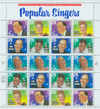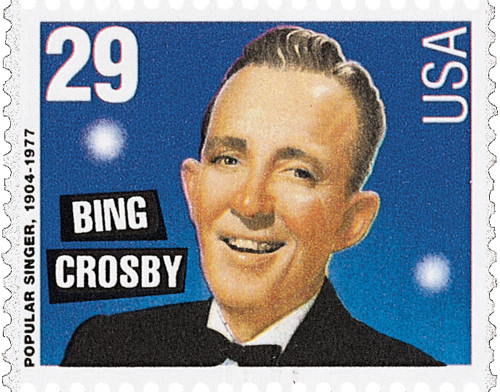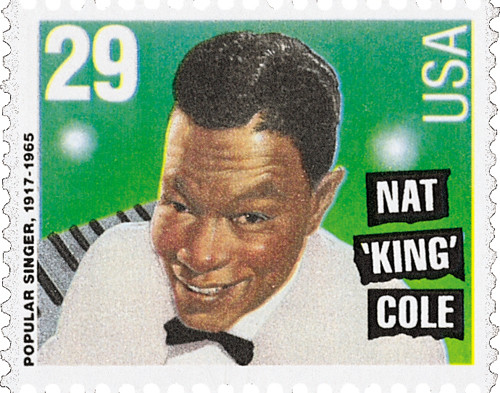
# 2849-53 - 1994 29c Popular Singers
US #2849-53
1994 Popular Singers
- Part of the Legends of American Music series
- Features five famous singers from the 20th century
Category of Stamp: Commemorative
Set: Legends of American Music series
Value: 29¢
First Day of Issue: September 1, 1994
First Day City: New York, New York
Quantity Issued: 35,436,000
Printed by: Stamp Venturers
Printing Method: Photogravure
Format: Panes of 20, from printing cylinders of 180 subjects (12 across, 15 down)
Perforations: 10.2 X 10.2
Reason the stamp was issued: The Popular Singers stamps were issued as part of the Legends of American Music series. They honor some of the most famous popular singers of the 20th century.
About the stamp design: Artist and magazine illustrator C.F. Payne was chosen to create the artwork for the Popular Singers stamps. Using photos provided by the USPS, he produced color sketches, then painted the singers using acrylic, watercolor, ink, oil paint, colored pencils, and airbrush.
Special design details: The background colors were chosen to fade into one another to give a sense of continuity to the set.
First Day City: The First Day of Issue ceremony took place at Damrosch Park in New York City. Family members and friends of those honored on the stamps were present at the ceremony. The ceremony also launched the US Postal Service’s month long American Music Stamp Festival.
Unusual thing about this stamp: During the planning for these stamps, it was decided birth and death dates would be added on the edge of each stamp. After the stamps were issued, Nat “King” Cole’s widow informed the USPS they had the wrong birth date. He had been born in 1919, not 1917 as shown on the stamp. Future stamps in this series don’t contain these dates to avoid another mistake.
About the Legends of American Music Series: The Legends of American Music Series debuted on January 8, 1993, and ran until September 21, 1999. The stamps were issued in semi-jumbo size. The name of each performer is in white letters, sometimes on a black background to make it stand out. The name of the set is shown running up the left side of the stamp.
More than 90 artists are represented from all styles of music: rock ‘n’ roll, rhythm and blues, country and western, jazz and pop, opera and classical, gospel and folk. In addition to individual singers and Broadway musicals, subjects include band leaders, classical composers, Hollywood songwriters and composers, conductors, lyricists, and more. The Legends of American Music Series was a huge advancement for diversity because it honored many Black and female artists.
History the stamp represents: The following singers are featured on these stamps:
Al Jolson
Born Asa Yoelson in Srednike, Lithuania, Al Jolson emigrated with his family to the United States when he was seven. The family settled in Washington DC, where his father, a rabbi and cantor, hoped his son would follow in his footsteps. But religious music was not for Jolson, who began appearing in burlesque and vaudeville shows at age 13.
His exuberant singing style and personal magnetism made him a favorite with audiences, and in 1911 he made his Broadway debut in La Belle Paree. It was during the production of Sinbad in 1918 that he made the Gershwin tune “Swanee” his trademark number. Other Jolson classics include “My Mammy,” “California, Here I Come,” “April Showers,” and “Toot, Toot, Tootsie.”
In 1927, the “king of pop” made film history when he starred in The Jazz Singer. The first feature film with synchronized speech, music, and sound effects, this picture revolutionized the motion picture industry and marked the end of the silent film era. Throughout the 1920s and ’30s Jolson continued to appear in films, and in 1946 the story of his life was filmed in The Jolson Story. A sequel, Jolson Sings Again, was filmed in 1949.
Bing Crosby
Born Harry Lillis Crosby in Spokane, Washington, “Bing” Crosby, as he came to be known, got his nickname from a character in the Bingville Bugle, a comic in the Sunday paper. Beginning his career as a jazz singer, he went on to become the most popular entertainer of his day.
Called “the greatest entertainer of the 20th century,” Crosby made more non-rock recordings and placed more songs in the “Top Ten” than any other individual singer. His career as an entertainer spanned more than 50 years, during which time he recorded over 1,600 songs and sold more than 500 million records. His recording of “White Christmas” remains the biggest selling record in history and has become a Christmas tradition.
Crosby’s charms extended from radio to screen, and in 1927 he appeared in the film King of Jazz. He went on to make more than 70 films – mostly musicals and romantic comedies. In 1940, he co-starred with Bob Hope and Dorothy Lamour in the highly successful Road to Singapore. Five other “Road” films followed to: Zanzibar, Morocco, Utopia, Rio, and Bali. In 1944, Crosby won an Academy Award for his portrayal of Father O’Malley in the movie Going My Way.
Ethel Waters
As a singer, dancer, and actress, Ethel Waters exercised her musical creativity and dramatic expression to gain prominence on the stage and in films. Billed as “Baby Star,” she made her first performance when she was five, in a children’s church program.
At age 17, she began her professional career performing song and dance routines on vaudeville. For her debut she sang W.C. Handy’s classic “St. Louis Blues,” becoming the first woman to sing the song professionally. Billed as “Sweet Mama Stringbean,” she became an overnight success with her low, sweet style of singing the blues.
In 1927, Waters made her Broadway debut in the all-black production Africana, and three years later firmly established her acting career when she starred in Blackbirds. But it was her sensitive performance in Cabin in the Sky (1940) that won her critical acclaim as a dramatic actress. She went on to star in the Hollywood film version of the play, and later appeared in Pinky (1949) and Member of the Wedding (1953).
Called “The Mother of Modern Popular Singing,” Waters spent the last 15 years of her life singing at the Billy Graham Crusades, during which time she made famous the song “His Eye is on the Sparrow.”
Nat “King” Cole
Described as “one of the greatest singers of the century,” Nat “King” Cole is best remembered for his satiny-smooth voice, although he originally began his career as a jazz pianist. In fact, his style of using the piano as a solo, rather than a rhythm instrument inspired other pianists to form similar groups and is an influence still felt in the jazz world today.
Kole began to play music as the organist at his father’s church, but he turned to playing at jazz clubs and later formed the popular King Cole Trio – one of the first black groups to have their own radio show. In 1943, his recording of “Straighten up and Fly Right” won him fame as a singer, and although he would continue to perform as a jazz musician, his image as a singer would dominate the rest of his career. By the early 1950s, Cole’s music turned to pop with “Walking My Baby Back Home,” “It’s Only a Paper Moon,” and “For Sentimental Reasons.”
Riding on the success of what is considered his best remembered hit “When I Fall in Love,” Cole broke color barriers and made musical history when he was given his own musical TV series. Popular for more than two decades, other successes such as “Mona Lisa” and “Unforgettable,” helped him attain lasting acceptance by audiences throughout the world.
Ethel Merman
Born in Astoria, New York, Ethel Zimmermann eventually dropped the “Zim” and the final “n” from her name, to become Ethel Merman. A self-taught singer who was described as “a doll from Astoria with a trumpet in her throat,” she worked as a secretary and part-time performer until she received her big break into show business.
In 1930, her performance in George Gershwin’s musical Girl Crazy catapulted her overnight from an obscure nightclub singer to a superstar of Broadway. Known as the “Queen of Broadway,” her dazzling career lasted more than 50 years. With her clear, sharp, vibrant voice and spontaneous presentations, she was a favored performer for many of the major songwriters of the day, including Irving Berlin, Cole Porter, and Rodgers and Hammerstein.
In 1934 she made her movie debut. However, she continued to dominate the spotlights of Broadway where she achieved her most notable success in Anything Goes (1934), Red, Hot, and Blue (1936), Annie Get Your Gun (1946), Call Me Madam (1950), and Gypsy (1959). In 1972, Merman was awarded a special Tony Award in recognition of her lifetime contribution to show business.
US #2849-53
1994 Popular Singers
- Part of the Legends of American Music series
- Features five famous singers from the 20th century
Category of Stamp: Commemorative
Set: Legends of American Music series
Value: 29¢
First Day of Issue: September 1, 1994
First Day City: New York, New York
Quantity Issued: 35,436,000
Printed by: Stamp Venturers
Printing Method: Photogravure
Format: Panes of 20, from printing cylinders of 180 subjects (12 across, 15 down)
Perforations: 10.2 X 10.2
Reason the stamp was issued: The Popular Singers stamps were issued as part of the Legends of American Music series. They honor some of the most famous popular singers of the 20th century.
About the stamp design: Artist and magazine illustrator C.F. Payne was chosen to create the artwork for the Popular Singers stamps. Using photos provided by the USPS, he produced color sketches, then painted the singers using acrylic, watercolor, ink, oil paint, colored pencils, and airbrush.
Special design details: The background colors were chosen to fade into one another to give a sense of continuity to the set.
First Day City: The First Day of Issue ceremony took place at Damrosch Park in New York City. Family members and friends of those honored on the stamps were present at the ceremony. The ceremony also launched the US Postal Service’s month long American Music Stamp Festival.
Unusual thing about this stamp: During the planning for these stamps, it was decided birth and death dates would be added on the edge of each stamp. After the stamps were issued, Nat “King” Cole’s widow informed the USPS they had the wrong birth date. He had been born in 1919, not 1917 as shown on the stamp. Future stamps in this series don’t contain these dates to avoid another mistake.
About the Legends of American Music Series: The Legends of American Music Series debuted on January 8, 1993, and ran until September 21, 1999. The stamps were issued in semi-jumbo size. The name of each performer is in white letters, sometimes on a black background to make it stand out. The name of the set is shown running up the left side of the stamp.
More than 90 artists are represented from all styles of music: rock ‘n’ roll, rhythm and blues, country and western, jazz and pop, opera and classical, gospel and folk. In addition to individual singers and Broadway musicals, subjects include band leaders, classical composers, Hollywood songwriters and composers, conductors, lyricists, and more. The Legends of American Music Series was a huge advancement for diversity because it honored many Black and female artists.
History the stamp represents: The following singers are featured on these stamps:
Al Jolson
Born Asa Yoelson in Srednike, Lithuania, Al Jolson emigrated with his family to the United States when he was seven. The family settled in Washington DC, where his father, a rabbi and cantor, hoped his son would follow in his footsteps. But religious music was not for Jolson, who began appearing in burlesque and vaudeville shows at age 13.
His exuberant singing style and personal magnetism made him a favorite with audiences, and in 1911 he made his Broadway debut in La Belle Paree. It was during the production of Sinbad in 1918 that he made the Gershwin tune “Swanee” his trademark number. Other Jolson classics include “My Mammy,” “California, Here I Come,” “April Showers,” and “Toot, Toot, Tootsie.”
In 1927, the “king of pop” made film history when he starred in The Jazz Singer. The first feature film with synchronized speech, music, and sound effects, this picture revolutionized the motion picture industry and marked the end of the silent film era. Throughout the 1920s and ’30s Jolson continued to appear in films, and in 1946 the story of his life was filmed in The Jolson Story. A sequel, Jolson Sings Again, was filmed in 1949.
Bing Crosby
Born Harry Lillis Crosby in Spokane, Washington, “Bing” Crosby, as he came to be known, got his nickname from a character in the Bingville Bugle, a comic in the Sunday paper. Beginning his career as a jazz singer, he went on to become the most popular entertainer of his day.
Called “the greatest entertainer of the 20th century,” Crosby made more non-rock recordings and placed more songs in the “Top Ten” than any other individual singer. His career as an entertainer spanned more than 50 years, during which time he recorded over 1,600 songs and sold more than 500 million records. His recording of “White Christmas” remains the biggest selling record in history and has become a Christmas tradition.
Crosby’s charms extended from radio to screen, and in 1927 he appeared in the film King of Jazz. He went on to make more than 70 films – mostly musicals and romantic comedies. In 1940, he co-starred with Bob Hope and Dorothy Lamour in the highly successful Road to Singapore. Five other “Road” films followed to: Zanzibar, Morocco, Utopia, Rio, and Bali. In 1944, Crosby won an Academy Award for his portrayal of Father O’Malley in the movie Going My Way.
Ethel Waters
As a singer, dancer, and actress, Ethel Waters exercised her musical creativity and dramatic expression to gain prominence on the stage and in films. Billed as “Baby Star,” she made her first performance when she was five, in a children’s church program.
At age 17, she began her professional career performing song and dance routines on vaudeville. For her debut she sang W.C. Handy’s classic “St. Louis Blues,” becoming the first woman to sing the song professionally. Billed as “Sweet Mama Stringbean,” she became an overnight success with her low, sweet style of singing the blues.
In 1927, Waters made her Broadway debut in the all-black production Africana, and three years later firmly established her acting career when she starred in Blackbirds. But it was her sensitive performance in Cabin in the Sky (1940) that won her critical acclaim as a dramatic actress. She went on to star in the Hollywood film version of the play, and later appeared in Pinky (1949) and Member of the Wedding (1953).
Called “The Mother of Modern Popular Singing,” Waters spent the last 15 years of her life singing at the Billy Graham Crusades, during which time she made famous the song “His Eye is on the Sparrow.”
Nat “King” Cole
Described as “one of the greatest singers of the century,” Nat “King” Cole is best remembered for his satiny-smooth voice, although he originally began his career as a jazz pianist. In fact, his style of using the piano as a solo, rather than a rhythm instrument inspired other pianists to form similar groups and is an influence still felt in the jazz world today.
Kole began to play music as the organist at his father’s church, but he turned to playing at jazz clubs and later formed the popular King Cole Trio – one of the first black groups to have their own radio show. In 1943, his recording of “Straighten up and Fly Right” won him fame as a singer, and although he would continue to perform as a jazz musician, his image as a singer would dominate the rest of his career. By the early 1950s, Cole’s music turned to pop with “Walking My Baby Back Home,” “It’s Only a Paper Moon,” and “For Sentimental Reasons.”
Riding on the success of what is considered his best remembered hit “When I Fall in Love,” Cole broke color barriers and made musical history when he was given his own musical TV series. Popular for more than two decades, other successes such as “Mona Lisa” and “Unforgettable,” helped him attain lasting acceptance by audiences throughout the world.
Ethel Merman
Born in Astoria, New York, Ethel Zimmermann eventually dropped the “Zim” and the final “n” from her name, to become Ethel Merman. A self-taught singer who was described as “a doll from Astoria with a trumpet in her throat,” she worked as a secretary and part-time performer until she received her big break into show business.
In 1930, her performance in George Gershwin’s musical Girl Crazy catapulted her overnight from an obscure nightclub singer to a superstar of Broadway. Known as the “Queen of Broadway,” her dazzling career lasted more than 50 years. With her clear, sharp, vibrant voice and spontaneous presentations, she was a favored performer for many of the major songwriters of the day, including Irving Berlin, Cole Porter, and Rodgers and Hammerstein.
In 1934 she made her movie debut. However, she continued to dominate the spotlights of Broadway where she achieved her most notable success in Anything Goes (1934), Red, Hot, and Blue (1936), Annie Get Your Gun (1946), Call Me Madam (1950), and Gypsy (1959). In 1972, Merman was awarded a special Tony Award in recognition of her lifetime contribution to show business.

















